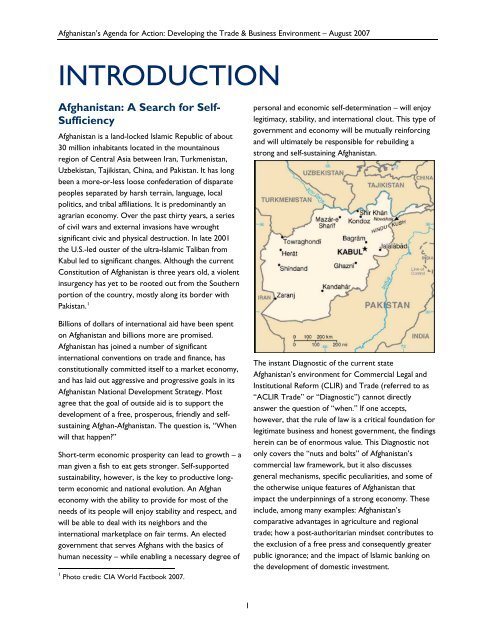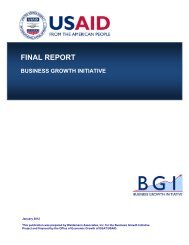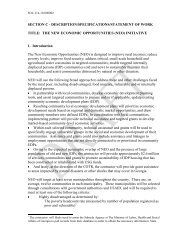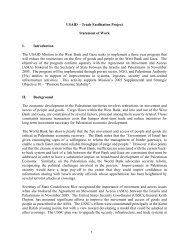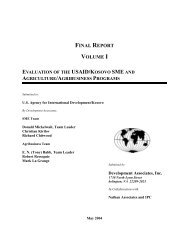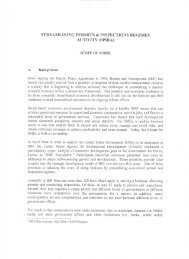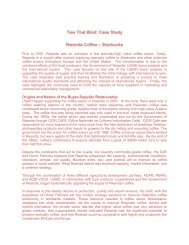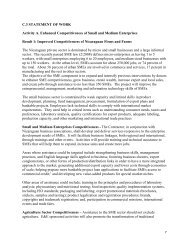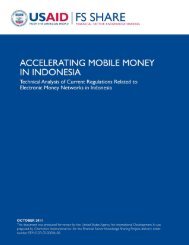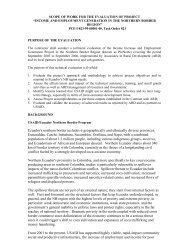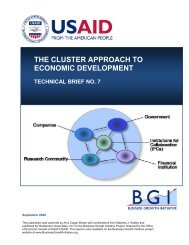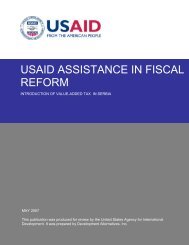Afghanistan's Agenda for Action - Economic Growth - usaid
Afghanistan's Agenda for Action - Economic Growth - usaid
Afghanistan's Agenda for Action - Economic Growth - usaid
Create successful ePaper yourself
Turn your PDF publications into a flip-book with our unique Google optimized e-Paper software.
Afghanistan’s <strong>Agenda</strong> <strong>for</strong> <strong>Action</strong>: Developing the Trade & Business Environment – August 2007INTRODUCTIONAfghanistan: A Search <strong>for</strong> Self-SufficiencyAfghanistan is a land-locked Islamic Republic of about30 million inhabitants located in the mountainousregion of Central Asia between Iran, Turkmenistan,Uzbekistan, Tajikistan, China, and Pakistan. It has longbeen a more-or-less loose confederation of disparatepeoples separated by harsh terrain, language, localpolitics, and tribal affiliations. It is predominantly anagrarian economy. Over the past thirty years, a seriesof civil wars and external invasions have wroughtsignificant civic and physical destruction. In late 2001the U.S.-led ouster of the ultra-Islamic Taliban fromKabul led to significant changes. Although the currentConstitution of Afghanistan is three years old, a violentinsurgency has yet to be rooted out from the Southernportion of the country, mostly along its border withPakistan. 1Billions of dollars of international aid have been spenton Afghanistan and billions more are promised.Afghanistan has joined a number of significantinternational conventions on trade and finance, hasconstitutionally committed itself to a market economy,and has laid out aggressive and progressive goals in itsAfghanistan National Development Strategy. Mostagree that the goal of outside aid is to support thedevelopment of a free, prosperous, friendly and selfsustainingAfghan-Afghanistan. The question is, “Whenwill that happen?”Short-term economic prosperity can lead to growth – aman given a fish to eat gets stronger. Self-supportedsustainability, however, is the key to productive longtermeconomic and national evolution. An Afghaneconomy with the ability to provide <strong>for</strong> most of theneeds of its people will enjoy stability and respect, andwill be able to deal with its neighbors and theinternational marketplace on fair terms. An electedgovernment that serves Afghans with the basics ofhuman necessity – while enabling a necessary degree of1 Photo credit: CIA World Factbook 2007.personal and economic self-determination – will enjoylegitimacy, stability, and international clout. This type ofgovernment and economy will be mutually rein<strong>for</strong>cingand will ultimately be responsible <strong>for</strong> rebuilding astrong and self-sustaining Afghanistan.The instant Diagnostic of the current stateAfghanistan’s environment <strong>for</strong> Commercial Legal andInstitutional Re<strong>for</strong>m (CLIR) and Trade (referred to as“ACLIR Trade” or “Diagnostic”) cannot directlyanswer the question of “when.” If one accepts,however, that the rule of law is a critical foundation <strong>for</strong>legitimate business and honest government, the findingsherein can be of enormous value. This Diagnostic notonly covers the “nuts and bolts” of Afghanistan’scommercial law framework, but it also discussesgeneral mechanisms, specific peculiarities, and some ofthe otherwise unique features of Afghanistan thatimpact the underpinnings of a strong economy. Theseinclude, among many examples: Afghanistan’scomparative advantages in agriculture and regionaltrade; how a post-authoritarian mindset contributes tothe exclusion of a free press and consequently greaterpublic ignorance; and the impact of Islamic banking onthe development of domestic investment.1


